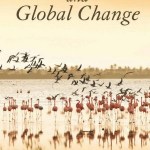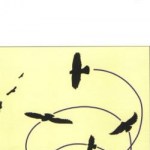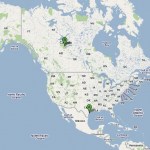migration
Image of ruby-throated hummingbird by Joe Schneid, Louisville, Kentucky (Own work) [CC BY 3.0 (http://creativecommons.org/licenses/by/3.0)], via Wikimedia Commons
In a new study published in The Auk, scientists report that well-fueled older tiny Ruby-throated Hummingbirds (Archilochus colubris) might be capable of non-stop flights of over 4,000 kilometers, wind conditions permitting. They made this remarkable observation while studying birds from 2010-2014 as the animals made stopovers at a wildlife refuge during their annual migration to South…
"Branta canadensis 4014" by Dori - Own work. Licensed under CC BY-SA 3.0 us via Wikimedia Commons - https://commons.wikimedia.org/wiki/File:Branta_canadensis_4014.jpg#/med…
A study published earlier this month examined how Canada geese (Branta canadensis), long-distance migratory birds, regulate their blood sugar levels during prolonged fasting. Dr. Jean-Michel Weber and Eric Vaillancourt (University of Ottawa, Ontario, Canada) were interested in understanding whether the pancreatic hormone glucagon could alter blood sugar in the birds. In mammals, glucagon maintains…
Check out my latest contribution to the bird blog 10,000 birds:
Faithful Loons and Human Lunacy
Every year there manage to be two Loons out in front of the cabin, up in Minnesota’s lake country. They nest on the same, ever-expanding semi-floating but occasionally shrinking nest over behind the point, so we can’t see the nest without going across the marsh in a canoe. It is a great place to nest, but for one small detail. Behind the embayment formed by the point is a tall bluff, the edge of an ancient river valley that passed through the area during one or more (probably a few) prior…
Canadian Geese. Image take near Lakeview, OR. Image from: Bureau of Land Management
A new study conducted by researchers Eric Vaillancourt and Jean-Michel Weber at the University of Ottawa examined blood sugar regulation in a bird that specialize in long distance migration, the Canada goose (Branta canadensis, image above). As referenced in the study published in the American Journal of Physiology - Regulatory, Integrative and Comparative Physiology, Canadian geese migrate approximately 7,000 km on their way to the Arctic, a trip that includes non-stop flights of up to…
Image from the American Physiological Society's website.http://www.the-aps.org/mm/Conferences/APS-Conferences/2014-Conferences/…
Tuesday was no less exciting than Monday!
Here are some highlights:
I thoroughly enjoyed a session called "Overcoming a Major Physiological Barrier: Adaptation from Saline to Freshwater Habitats" which highlighted the need for several species to shift how they regulate ion balance when they migrate between fresh water (ion absorption from the water) and salt water (ion secretion to the water).
Clements K, Bojarski L, Johnson K, McMillan S, White L, Angert E (Univ…
"Actually, I wasn't happy or sad. I was medium. And medium is the happiest that I'll ever be." -Axe Cop
It's been an amazing journey over the years, sharing the joys and wonders of the Universe with you. From the smallest subatomic particles, the most fundamental interactions and the shortest timescales imaginable to the stars, galaxies, clusters, superclusters and beyond, we've spent the better part of the last five years together here on ScienceBlogs exploring the most interesting aspects of physical reality together.
Image credit: NASA, ESA, F. Paresce (INAF-IASF), R. O'Connell (UVa…
My personal genealogy has never interested me much, knowing as I do that the number of ancestors multiplies by a factor of two with each generation. Thus in AD 1800 someone born in 1975 had about 2^8=256 ancestors of child-bearing age (or slightly fewer if someone has been productive in more than one slot on the diagram). Finding out that a historical figure contributed 1/256 to my genetics and social heritage would not make them all that much more interesting to me.
I draw the line at three generations back, with people that are still remembered. In my case they illustrate an interesting and…
I came across this video showing thousands of migratory birds circling the Tribute in Lights yesterday. The birds were migrating along the Atlantic Flyway and were disoriented by the lights. Other birds may have been attracted to the large number of insects and smaller birds caught up in the lights as prey (Cornell Lab of Ornithology). To reportedly help re-orient the birds and prevent exhaustion, volunteers from the NYC Audubon turned off the spotlights temporarily.
Video taken by: Shervin Pishevar
The lights are xenon searchlights in lower Manhattan arranged by artist Gustavo Bonevardi to…
When wildebeest, such as those famous for crossing the Mara River in Tanzania during their annual migration, run into a crocodile or some other danger it is often the first time they've seen that particular thing. This is because most wildebeest don't live very long so many are on their very first migration. One wonders what would happen if you killed all of the wildebeest migrating in a particular year and set new ones out on the landscape to take their place. Would the migration continue?
Probably not, initially. Something like this did in fact happen on the Botswana-South Africa-…
I'm going to have more to say about this topic and this book at a later time, but I wanted to get a notice of it out for Migration Week. Bird Migration and Global Change by George W. Cox addresses the issue of impact on bird populations under conditions of global warming.
This is an authoritative and scholarly book that is totally accessible to the interested bird-oriented or climate/conservation-oriented audience. After several very important context and theory chapters, the author divides the world's migratory birds into major categories (such as "Northern Hemisphere Land Birds: Short…
As part of Migration Week (inspired by this post), I'm covering migration related books (mainly having to do with birds). How Birds Migrate by Paul Kerlinger (with Illustrations by Pat Archer), Second Edition, is an affordable, up to date (2009 publication) comprehensive and intelligently written book. It is written for the general public but is not dumbed down.
The thing about bird migration is that there are many facets to the behavior. There are different kinds of birds, with respect to the nature of their flight, body size, etc (think albatross vs. hummingbird). There are many kinds…
They used to hunt whooping cranes. Between that and habitat loss, the number dropped from nearly 20,0000 to a mere 1,400 during the first half of the 19th century, and continued to drop to an all time low of 15 birds in 1941.
Fifteen birds, in 1941, represented the entire species.
All those birds were members of a single flock that migrated between the Aransas National Wildlife Refuge in Texas, USA and Wood Buffalo National Park in Canada.
Most people know the story, or at least, the vague outlines of the story. Much has been written about them, including several books such as Cranes:…
These are the kinds of books you get if you are either a scientists studying bird migration and related issues, or a very serious bird geek. The first two can be obtained at very low prices used, but the third will set you back at least 50 bucks US$ if you want a used copy. Note the spread of publication dates. It is not the case that the oldest book is out of date in all respects: Quite the contrary. Alerstam reviews theory and ideas that have not been revisited or revised to any great degree. Also, it is interesting to see how changes in the field develop over a decade or so. In any…
On the Wing: American Birds in Migration is a children's book suitable for up to Middle School or thereabouts. Remarkably, this ten year old volume is actually fairly accurate and comprehensible, covering most of the major aspects of bird migration, discussion ecological patterns, mechanisms, and methods used to study the phenomenon.
It is written and illustrated by Carol Lerner, who has prodcued well over a dozen anture related books of similar (high) quality including Butterflies in the Garden and Backyard Birds of Summer. Since these books are all at least ten years old you can find…
On the Move: How and Why Animals Travel in Groups, edited by Sue Boinski and Paul Garber is a compendium of academic research on ... well, on how and why animals travel in groups. Notice of this book is a fitting start to a series of reviews of migration-related books that is part of Migration Week on GLB. (For an overview of the Bigness and Vastness of bird migration in particular, see A Question of Migration.)
Group movement is only rarely migration, though the two phenomena are overlapping subsets. An example of group movement that demands some explanation is that found in chimpanzees…
tags: evolutionary biology, behavioral ecology, biochemistry, biophysics, magnetoreception, photoreceptor, cryptochromes, geomagnetic fields, butterflies, Monarch Butterfly, Danaus plexippus, birds, migration, signal transduction, researchblogging.org,peer-reviewed research, peer-reviewed paper
Every autumn, millions of monarch butterflies, Danaus plexippus, each weighing less than one gram (one US penny weighs 2.5 grams), migrate nearly 4000 kilometers (3000 miles) between their summer breeding grounds in the United States and their wintering areas either in southern California or in the…
tags: evolutionary biology, behavioral ecology, life history, migration, long-distance migration,birds,ornithology,researchblogging.org,peer-reviewed research, peer-reviewed paper
White-rumped sandpiper, Calidris fuscicollis, chicks on Bylot Island, Nunavut, Canada.
Image: Laura McKinnon [larger view]
I recently told you about research that used new microtechnology to document the incredible journey of Arctic Terns, a small bird species that annually migrates from its wintering area in Antarctica to its breeding colonies in Arctic and sub-Arctic regions of Europe, Asia, and North America…
I've just flown from London to North Carolina, a trip of around 6,200km. As flights go, it's a pathetic one, a mere jaunt in the park compared to the epic voyage of the Arctic tern. Every year, this greatest of animal travellers makes a 70,000 km round-trip, in a relentless, globe-trotting pursuit of daylight. In summer, it spends its time in the sun-soaked Arctic and in winter, it heads for the equally bright climes of Antarctica. In its 30 years of life, this champion aeronaut flies more than 2.4 million kilometres - the equivalent of three return journeys to the Moon.
The…
tags: evolutionary biology, behavioral ecology, migration, microtechnology, geolocator, natural history, biological hotspots, longest migration, seabirds, Arctic Tern, Sterna paradisaea, researchblogging.org,peer-reviewed research, peer-reviewed paper
Arctic Tern, Sterna paradisaea, Iceland.
Image: Arthur Morris, Birds as Art, 2007 [larger view].
Canon 400mm f/5.6L lens (handheld) with the EOS-1D Mark III. ISO 200. Evaluative metering +1/3 stop: 1/1000 sec. at f/5.6 in Manual mode. Manual Flash with Better Beamer at 1:1.
For decades, it was widely suspected that a small seabird, the…
In the forests of Germany live large numbers of blackcaps, a small species of songbird. They all look very similar, but they actually belong to two genetically distinct groups that are becoming more disparate with time. For the moment, the best way to tell them apart is to wait for winter. As the cold sets in, one group of blackcaps flies southwest to Spain, while a smaller group heads northwest towards Britain.
If the prospect of spending winter in Britain rather than Spain seems odd to you, you're not alone. Indeed, blackcaps were hardly ever ventured across these shores before the 1950s.…




